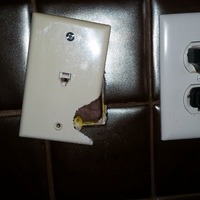The onset of winter each year creates an increasing number of problems for homeowners, especially those living in inadequately-insulated or older homes. Rats, mice and other rodents begin scurrying back to the warmth of homes and office buildings as temperatures begin to drop outside.
Much of Canada has been experiencing warmer winters over the last few years. Because more rats are surviving the winter months this explains the boom in rodent populations across the country. Warmer winters translate into increased rates at which rodents reproduce creating a need for rats and mice to look for more places to hide. There are actually many signs that signal rodents have taken up residence at a particular location, some of which include:
- Evidence of nesting
- Damage to property
- Rodent tracks
- Fecal matter
Evidence Of Nesting
Shredded materials such as paper, cardboard or plants can be a sign that a new nest is being made. Nests are usually made far out of sight, so it’s important to be thorough and check everything. They are usually built in low traffic areas where there isn’t a lot of people walking by.
Damage To Property
Rats and mice like to chew on things, so gnawed furniture is a dead giveaway. As rodents look for nesting materials, check your warehouse or garage for chewed out boxes or furniture. Evidence of feeding should be reported immediately, and food products will be a prime target for rats and mice.
Rodent Tracks
Footprints and rail swipes are dead giveaways of rodent movement. Mice and rats tend to use the same paths to and from their nests, so look for dirty or greasy smear marks on the floor. Rodents often move through secluded areas, so that’s where you should look for signs of activity from them.
Fecal Matter
All animals have to leave droppings. At least rodent feces are easy to spot, especially compared to insect droppings. Keep a lookout for such things and make sure your family members know what to look out for and what to do in this case. if you are a business owner make sure your staff knows what to do and that there is a policy in place to protect everyone involved.
Much of the previously mentioned is usable year-round, but becomes even more important in the winter time. The scarcity of food makes it a must to make sure every bit of food is under constant lock and key. Plastic containers are a must, as rodents look for any bit of food they can get their paws on. Animal based businesses need to make sure their food supplies are safe and sound as warmer winters make it more comfortable for rodents to scurry around and cause damage.
Drywall is one of the easiest items for rats to break through.Faced With A Rat Infestation After A Warm Winter? Contact Skedaddle
The issue of warmer winters causing increasing rodent infestation problems is one that no one single home or business owner can solve single handedly. On the other hand, there is plenty you can do if your home is shared with a rat population as a result of a not-so-cold winter.
A professional approach is always the recommended option and there’s no better choice for a professional rodent control company then Skedaddle Humane Wildlife Services. In addition
to being available year-round, Skedaddle has almost three decades of experience when it comes to dealing with rat and other rodent infestations in homes and businesses. Humane removal techniques, followed by sanitization and future-proofing services are the Skedaddle way; one which results in never having to see another rat in your home again. Get in touch with Skedaddle today and solve your rat infestation problem with professional help.



